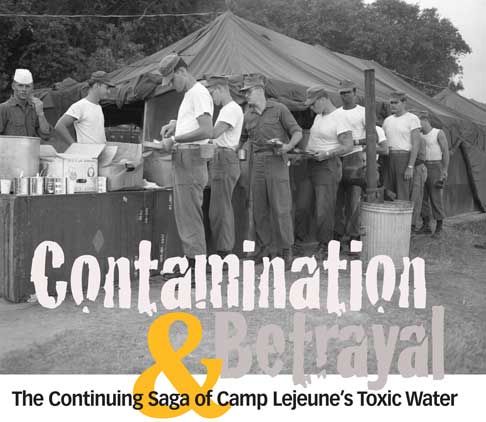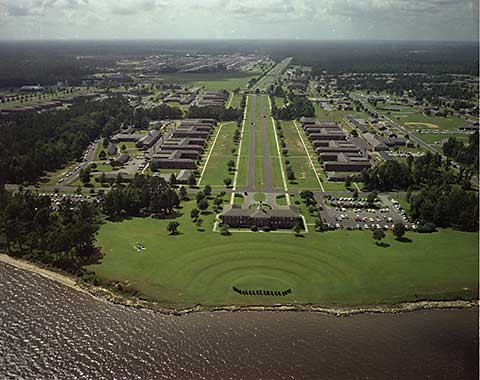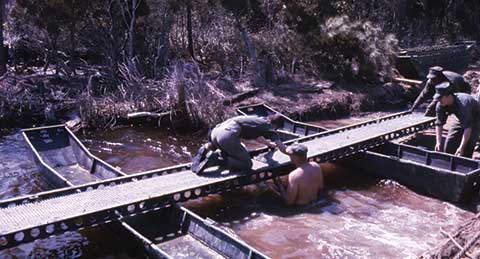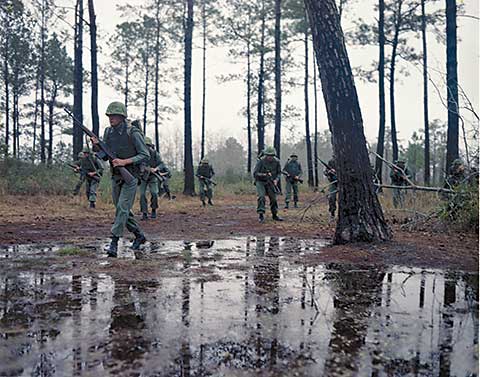 |
||||||||||||
|
May/June 2016
BY RICHARD CURREY From at least the late 1950s through the mid-1980s, the water supply at Camp Lejeune, the Marine base in southeastern North Carolina, was contaminated with high levels of volatile organic compounds (VOCs). These chemicals, which include benzene, trichloroethylene (TCE), and perchloroethylene (PCE or “perc”), are used in fuels, degreasers, sealants, lubricants, paints, varnishes, and pesticides. They are exceedingly common in the environment. But humans exposed to these chemicals risk a sad litany of medical outcomes including birth defects; kidney, liver, and nervous system damage; stillbirths and infant death; and a terrible array of cancers. VOCs were the chemicals that leached, invisible and unsuspected, for more than thirty years into Le-jeune’s run-off streams, wells, and water supply systems. The source was initially thought to be an off-base laundry where workers dumped used dry cleaning fluid behind the store, which then filtered into groundwater. But in time other sources of contamination were found, all on the grounds of Camp Lejeune—unlined pits used as chemical and burn dumps, chemical waste stored in leaky drums and left to sit for years, sites where thousands of gallons of battery acid and machine oil were poured directly onto the ground. Camp Lejeune’s toxin-laced water poured from showerheads in the enlisted barracks. It was used to brew morning coffee in the mess halls. It was the water that the base’s families drank, that service moms cooked with, that supplied the Naval Hospital’s clinics and wards, that bubbled up from the drinking fountains in base schools and day care centers, that filled the swimming pools, and that was piped to every base facility—from the commissary to the movie theaters. Many estimates place the number of exposed individuals during the entire period of uncontrolled contamination at nearly one million people. Public information about Camp Lejeune’s tainted water first emerged in the late 1990s, but military authorities were aware of the problem well before that. The chain of command, including the base commander, was notified in the early months of 1982 after testing revealed VOCs in Camp Lejeune water at nearly 300 times the level known to be safe. The Marine Corps claimed its failure to act upon learning of the contamination was based on an absence of established and enforceable drinking water standards. But this rationale had scant credibility. Richard Maas, then professor of environmental studies at the University of North Carolina-Asheville, noted in an interview in The Washington Post that solid science about water contaminant levels was readily available by the late 1970s. Maas said that the Lejeune levels, even in 1982, “would have constituted pretty close to a drinking water crisis.” The offending wells were capped in the mid-1980s. The EPA made Camp Lejeune a Superfund site in 1989, allocating millions of dollars in federal funds for cleanup. But the story was just beginning.
One of the earliest Lejeune water activists, retired Marine Master Sgt. Jerry Ensminger, has been on the case since 1997—from the time he first heard about a government report that revealed the multi-decade presence of contaminated water at Camp Lejeune. Ensminger was stationed there when his daughter, Janey, was conceived in 1975. After a stint at Parris Island, Ensminger transferred back to Lejeune. Janey had subtle physical difficulties from birth, but grew up an active and happy girl. In 1983 she came down with a case of strep throat she couldn’t seem to shake. Ensminger took her to the Naval Hospital at Camp Lejeune, where leukemia was diagnosed. Janey died in September 1985. Ensminger, as any parent would be, was devastated. He would be haunted for years to come. How could this sort of thing happen? Janey had been so vibrant and alert, so happy. How could such suffering be visited on a child? One August day in 1997 Ensminger saw a news report about an obscure government study that examined water contamination at Camp Lejeune. The study identified high levels of VOCs in Lejeune’s water and detailed the health hazards of exposure to VOCs, including leukemia. Ensminger, stunned by the implications, saw his life change in that moment. Over the years he has become the most recognizable face of the Lejeune debacle, an outspoken and unflagging voice for the human devastation wrought by the unfettered chemical contamination of a public water supply. “I’ve worked the Lejeune case for nineteen years and counting,” Ensminger said, a period in which the likelihood of his daughter’s death—and the illnesses and deaths of many others—has been connected by numerous scientific studies to the poisonous stew of chemicals that once flowed in Camp Lejeune’s water. But Ensminger is far more than a torchbearer for the injured and aggrieved. A tireless in-the-trenches advocate, he has built critical alliances, testified before Congress, and—along with fellow activists Mike Partain and retired Marine officer Tom Townsend—helped build a large, informed, and vocal community of Camp Lejeune victims.
The Lejeune saga has followed a labyrinthine path that many would call inevitable when the federal government is involved. There have been meetings, hundreds of them; studies conducted and data reviewed; regulations written and revised. Conclusions have been reached, challenged, retracted, re-studied, and re-released. The straightforward goal of bringing justice to those injured by Lejeune’s water has often seemed so distant as to be unreachable. But in time enough scientific puzzle pieces fell into place. The indictment of Lejeune’s toxic water as a key factor in significant illness and death is now established. The current position of the federal Agency for Toxic Substances and Disease Registry (ATSDR) is that “past exposures from the 1950s through February 1985 to [VOCs] and other contaminants in the drinking water at Camp Lejeune likely increased the risk of cancers (kidney, multiple myeloma, leukemias, and others), adverse birth outcomes, and other adverse health effects of residents (including infants and children), civilian workers, Marines and Naval personnel.” Another disease more recently associated with Lejeune’s tainted water is male breast cancer. Although exceedingly rare, a cluster of seventy-one cases was reported among Marines posted at Lejeune during the contamination years (as well as cases in exposed male Marine family members who lived on-base at the same time). This many breast cancer cases in any single group of men defies statistics—except for the fact that this group shared the single factor of exposure to Lejeune’s water. In a study published in September 2015, ATSDR researchers concluded that “findings suggest possible associations between male breast cancer and being stationed at Camp Lejeune, and cumulative exposures showed possible associations with earlier age at onset of male breast cancer.” These statements from government scientists, reached after years of study, would seemingly put Lejeune water victims on a fast track for medical care and compensation for their injuries and distress. It was not that simple, of course. But it was the beginning of what would become, in 2012, breakthrough legislation that mandated health care for some Lejeune victims, a key achievement in the years-long battle waged by Jerry Ensminger and his activist comrades in their search for justice and accountability. The genesis of the Honoring America’s Veterans and Caring For Camp Lejeune Families Act emerged in October 2009, but needed three years to get through committees, negotiations, and various scientific, policy, and legal debates before the Senate passed the Act on July 18, 2012. The House followed suit two weeks later. The bill, generally known as the Janey Ensminger Act, authorized medical care for fifteen specific maladies among military servicemembers and civilian employees who worked at Camp Lejeune, as well as family members who lived on the base between 1957 and 1987 and “developed conditions linked to the water contamination.” It’s not a perfect bill. For example, it mandates that family members of veterans or civilians who worked on-base during the “contamination years” must demonstrate that they have exhausted all forms of assistance for receiving and paying for medical care before VA coverage is approved. Another key element missing from the bill is a mechanism for giving disability status to Lejeune vets with water-related illnesses. “I was criticized for going along with some of the provisions of the bill,” Ensminger said. “But there’s a word in our language that most of today’s politicians—let alone the general public—seem to have forgotten: ‘compromise.’ If you’re ever going to make progress, you have to be willing to compromise. And I did. Because a pretty good law is better than what we had, which was no law at all.” Ensminger stood beside President Obama in the Oval Office as he signed the bill into law. After signing, the President said that it “ends a decades-long struggle for those who served at Camp Lejeune.” Not exactly, according to Ensminger. “This is not the epilogue,” he said in an interview with Stars and Stripes. “This is the end of the first act. We still have not gotten the whole truth, nor the accountability of the people who were responsible for perpetrating this.”
As the VA began to carry out the provisions of the Janey Ensminger Act, Lejeune activists prepared for the next challenge: establishing presumptive disability status for veterans harmed by Camp Lejeune’s water. The Janey Ensminger Act directs the VA to provide medical care for fifteen conditions, but receiving disability status based on illness linked to Lejeune service remains elusive. Of the more than 20,000 Lejeune disability claims filed in the last four years, only 864 were approved (6.5 percent). Yet nearly eight thousand Lejeune vets are receiving VA medical care for water-connected ailments. The discrepancy, according to a VA statement, is that many disability claims do not adequately connect medical conditions with toxic exposure. Ensminger believes that it goes deeper than that. At the heart of the matter is a controversial “subject matter expert” (SME) program employed by the VA to review Lejeune-related claims. “The VA created the SME program to review Camp Lejeune claims,” Ensminger said. “But the VA will not release the names of the SMEs who are making the recommendations, allegedly to protect their privacy. So we have no idea what kind of expertise or training these people actually have.” That point might not be an issue, except “the SME decisions are ridiculous,” Ensminger said. “They quote science that has long ago been refuted. They cite information that is simply untrue. They overlook results of medical testing. They directly contradict doctors’ statements.” Ensminger offered an example. Two disability decisions, rendered in January and February of 2015, rejected claims by Lejeune Marines with kidney cancer, an ailment related to trichloroethylene (TCE) exposure. “The SME reviewer wrote that he had read all the meta-analyses of all well-conducted scientific studies on TCE,” Ensminger said, “and could find no evidence that TCE causes or is related to any kind of cancer, let alone kidney cancer.
Ensminger sent the disability denials to Sens. Richard Burr (R-N.C.) and Thom Tillis (R-N.C.), who passed them on to Sen. Johnny Isakson (R-Ga.), chair of the Senate Committee on Veterans’ Affairs. A meeting with the senators, VA Secretary Bob McDonald, and ATSDR Director Patrick Breysse ensued. “Secretary McDonald said he would soon announce presumptive disability status for Camp Lejeune vets,” Ensminger said. He asked Dr. Breysse if he would commit his agency to help create a list of health conditions that will fall under this presumptive status. Not a week after that meeting took place, the VA announced that the Secretary had approved presumptive status for three health conditions. “Three?” Ensminger protested, other advocates protested, and the ATSDR re-analyzed all Lejeune water studies. The VA then agreed to accept all health effects that had moderate or significant levels of evidence relating them to VOCs. “So they came out with eight effects for presumptive disability status,” Ensminger said. “The VA said it would take up to two years to finalize regulations regarding administration of presumptive disability status in Lejeune cases—said it needed to develop a template. But that’s nonsense, because a presumptive disability template already exists. It’s called Agent Orange. We have Vietnam vets and VVA to thank for the hard work that went into that.” But even with the AO presumptive disability template in place as a model for Lejeune, it will still be at least another year before the VA begins to accept Lejeune claims under a presumptive disability program. In the end, Ensminger reflected, it comes back to human lives and the dire costs paid by individuals who saw their own best impulses betrayed. “If you step back and look at this,” Ensminger said, “it’s all about protecting the institution over the protection of people. An institution, in this case the Marine Corps, makes decisions—or chooses not to make decisions—that bring grievous, deadly harm to thousands of innocent people. But for the Corps it’s been about protecting the institution at the expense of the people who actually make the institution work.” Ensminger mused about the dark irony of his long-time devotion to the Marine Corps and his belief in the integrity of his service protecting the constitutional rights of his fellow citizens. “But when we Lejeune vets wanted to exercise those very rights, to get a hearing and justice, we were told to drop it, to shut up and go away.” The Lejeune story is essentially a version of what has become a widespread phenomenon, from Love Canal to the rivers of West Virginia and now, the poisoned water in Flint, Michigan. The homeowner, the worker, the kid going to school—or the Marine serving his or her country—“all become expendable,” Ensminger said. Thousands can die, “as long as the institution is protected. It’s a very sad scenario.” Once presumptive disability for Lejeune Marines and their families goes into effect, the next question will be what the VA should do with all the previously denied Lejeune claims. “The VA will no doubt say they won’t grandfather those claims into the system,” Ensminger said. “This is unacceptable. This will be one more battle in what has been a very long war. But we’ll keep pressure on the VA to have those denied claims revisited.” Great strides have been made. The Camp Lejeune contamination catastrophe has been widely reported. Necessary scientific studies have been done and continue. Legislation was enacted and many Lejeune Marines now receive medical care for water-related illnesses. Presumptive disability status is coming. Service families and survivors will be eligible for benefits, as will civilian workers on the base. Semper Fi, the prize-winning documentary film featuring Jerry Ensminger, has been seen by thousands. Journalist Mike Magner’s A Trust Betrayed, published in 2014, is the most comprehensive single account of the Lejeune debacle. But the job is not done. Ensminger acknowledged that he and his fellow advocates are engaged in an enterprise in which success is measured in inches. “If you think about Agent Orange and Vietnam vets, it took time. All the benefits didn’t come right away. It was incremental. It was slow. It was frustrating and maddening. And it took compromise all along the way. The Lejeune situation is no different. It’s one day at a time. One issue at a time. We’ll stay on this all the way.”
|
||||||||||||
|
|
||||||||||||
|
|
||||||||||||
8719 Colesville Road, Suite 100, Silver Spring. MD 20910 | www.vva.org | contact us |
||||||||||||






















 When we first wrote about Camp Lejeune’s toxic water in these pages in 2004, the tide of public outrage was just gathering steam. Grassroots advocacy groups of veterans and their family members had formed, bringing stories of disability and fatalities, of mysterious paralyses, unusual cancers, and the unexplained deaths of children. Those early advocates collected documents, issued press releases, lobbied for action from elected officials and the Marine Corps hierarchy, and established an online presence to reach out to other potential victims.
When we first wrote about Camp Lejeune’s toxic water in these pages in 2004, the tide of public outrage was just gathering steam. Grassroots advocacy groups of veterans and their family members had formed, bringing stories of disability and fatalities, of mysterious paralyses, unusual cancers, and the unexplained deaths of children. Those early advocates collected documents, issued press releases, lobbied for action from elected officials and the Marine Corps hierarchy, and established an online presence to reach out to other potential victims.

 “But as recently as September 2011 the EPA reclassified TCE as a known human carcinogen. In 2012 the International Agency for Research on Cancer re-designated TCE as a known human carcinogen. And in 2014 our own National Toxicology Program followed suit. And the bulk of the evidence that drove those re-designations? Renal cell carcinoma—kidney cancer. And yet a VA SME wrote opinions that claimed there is no evidence that TCE is a carcinogen and denied benefits to two vets with kidney cancer. Is this really what the VA wants to stand behind? Is this taking care of our vets?”
“But as recently as September 2011 the EPA reclassified TCE as a known human carcinogen. In 2012 the International Agency for Research on Cancer re-designated TCE as a known human carcinogen. And in 2014 our own National Toxicology Program followed suit. And the bulk of the evidence that drove those re-designations? Renal cell carcinoma—kidney cancer. And yet a VA SME wrote opinions that claimed there is no evidence that TCE is a carcinogen and denied benefits to two vets with kidney cancer. Is this really what the VA wants to stand behind? Is this taking care of our vets?”